Submitted:
14 October 2024
Posted:
15 October 2024
You are already at the latest version
Abstract
Keywords:
1. Introduction
2. Materials and Methods
2.1. Experimental Site Description and Treatments
2.2. Application of Biochar, Urea, FYM, PM and Sowing of Wheat Seeds
2.3. Determination of the Post-Harvest, Soil Physico-Chemical Properties
2.4. Composition of Biochar, FYM and PM
2.5. Statistical Analysis
3. Results
3.1. Effect of Biochar and N Management on Soil Physical Properties
3.2. Effect of Biochar and N Management on Soil Chemical Properties
4. Discussion
5. Conclusions
Author Contributions
Funding
Data Availability Statement
Acknowledgments
Conflicts of Interest
References
- Chen, D.; Yuan, L.; Liu, Y.; Ji, J.; Hou, H. Long-term application of manures plus chemical fertilizers sustained high rice yield and improved soil chemical and bacterial properties. Eur. J. Agron. 2017, 90, 34–42. [Google Scholar] [CrossRef]
- Bhatt, M.K.; Labanya, R.; Joshi, H.C. Influence of Long-term Chemical fertilizers and Organic Manures on Soil Fertility - A Review. Univers. J. Agric. Res. 2019, 7, 177–188. [Google Scholar] [CrossRef]
- Barrow, C.J. Biochar: Potential for countering land degradation and for improving agriculture. Appl. Geogr. 2012, 34, 21–28. [Google Scholar] [CrossRef]
- Khan, M.A.; Basir, A.; Saeed, B. Biochar Improves Phenological and Physiological Attributes of Wheat in Soil Amended with Organic and Inorganic Nitrogen Sources. Sarhad J. Agric. 2020, 36. [Google Scholar] [CrossRef]
- Iqbal, A.; He, L.; Khan, A.; Wei, S.; Akhtar, K.; Ali, I.; Ullah, S.; Munsif, F.; Zhao, Q.; Jiang, L. Organic Manure Coupled with Inorganic Fertilizer: An Approach for the Sustainable Production of Rice by Improving Soil Properties and Nitrogen Use Efficiency. Agronomy 2019, 9, 651. [Google Scholar] [CrossRef]
- Amusan, A.O.; Adetunji, M.T.; Azeez, J.O.; Bodunde, J.G. Effect of the integrated use of legume residue, poultry manure and inorganic fertilizers on maize yield, nutrient uptake and soil properties. Nutr. Cycl. Agroecosystems 2011, 90, 321–330. [Google Scholar] [CrossRef]
- Adhikari, P.; Khanal, A.; Subedi, R. Effect of Different Sources of Organic Manure on Growth and Yield of Sweet Pepper. Adv. Plants Agric. Res. 2016, 3, 1–3. [Google Scholar] [CrossRef]
- Selim, M.M. Introduction to the Integrated Nutrient Management Strategies and Their Contribution to Yield and Soil Properties. Int. J. Agron. 2020, 2020, 1–14. [Google Scholar] [CrossRef]
- Singh, N.J.; Athokpam, H.S.; Devi, K.N.; Chongtham, N.; Singh, N.B.; Sharma, P. T.; Dayananda, S. Effect of farm yard manure and press mud on fertility status of alkaline soil under maize-wheat cropping sequence. Afr. J. Agric. Res. 2015, 10, 2421–2431. [Google Scholar]
- Sander, B.; Tarek, E. Biochar effect on the mineralization of soil organic matter. Pesqui. Agropecu. Bras. 2012, 47, 665–671. [Google Scholar]
- Lehmann, J. Bio-energy in the black. Front. Ecol. Environ. 2007, 5, 381–387. [Google Scholar] [CrossRef]
- Sohi, S.P.; Krull, E.; Lopez-Capel, E.; Bol, R. A review of biochar and its use and function in soil. Adv. Agron. 2010, 105, 47–82. [Google Scholar] [CrossRef]
- Harter, J.; Krause, H.-M.; Schuettler, S.; Ruser, R.; Fromme, M.; Scholten, T.; Kappler, A.; Behrens, S. Linking N2O emissions from biochar-amended soil to the structure and function of the N-cycling microbial community. ISME J. 2014, 8, 660–674. [Google Scholar] [CrossRef] [PubMed]
- Ma, N.; Zhang, L.; Zhang, Y.; Yang, L.; Yu, C.; Yin, G.; Doane, T.A.; Wu, Z.; Zhu, P.; Ma, X. Biochar Improves Soil Aggregate Stability and Water Availability in a Mollisol after Three Years of Field Application. PLOS ONE 2016, 11, e0154091. [Google Scholar] [CrossRef]
- de Jesus Duarte, S.; Glaser, B.; Pellegrino Cerri, C.E. Effect of Biochar Particle Size on Physical, Hydrological and Chemical Properties of Loamy and Sandy Tropical Soils. Agronomy 2019, 9, 165–180. [Google Scholar] [CrossRef]
- Cayuela, M.L.; Sánchez-Monedero, M.A.; Roig, A.; Hanley, K.; Enders, A.; Lehmann, J. Biochar and denitrification in soils: when, how much and why does biochar reduce N2O emissions? Sci. Rep. 2013, 3, 1–7. [Google Scholar] [CrossRef]
- Shah, Z.; Shah, T. Residual effect of biochar on soil properties and yield of maize (Zea mays L.) under different cropping systems. Open J. Soil Sci. 2018, 8, 16. [Google Scholar]
- Palansooriya, K.N.; Wong, J.T.F.; Hashimoto, Y.; Huang, L.; Rinklebe, J.; Chang, S.X.; Bolan, N.; Wang, H.; Ok, Y.S. Response of microbial communities to biochar-amended soils: a critical review. Biochar 2019, 1, 3–22. [Google Scholar] [CrossRef]
- Jing, Y.; Zhang, Y.; Han, I.; Wang, P.; Mei, Q.; Huang, Y. Effects of different straw biochars on soil organic carbon, nitrogen, available phosphorus, and enzyme activity in paddy soil. Sci. Rep. 2020, 10, 1–12. [Google Scholar] [CrossRef]
- Mensah, A.K.; Frimpong, K.A. Biochar and/or Compost Applications Improve Soil Properties, Growth, and Yield of Maize Grown in Acidic Rainforest and Coastal Savannah Soils in Ghana. Int. J. Agron. 2018, 2018, 1–8. [Google Scholar] [CrossRef]
- Kizito, S.; Luo, H.; Lu, J.; Bah, H.; Dong, R.; Wu, S. Role of Nutrient-Enriched Biochar as a Soil Amendment during Maize Growth: Exploring Practical Alternatives to Recycle Agricultural Residuals and to Reduce Chemical Fertilizer Demand. Sustainability 2019, 11, 3211. [Google Scholar] [CrossRef]
- Domingues, R.R.; Sánchez-Monedero, M.A.; Spokas, K.A.; Melo, L.C.A.; Trugilho, P.F.; Valenciano, M.N.; Silva, C.A. Enhancing Cation Exchange Capacity of Weathered Soils Using Biochar: Feedstock, Pyrolysis Conditions and Addition Rate. Agronomy 2020, 10, 824. [Google Scholar] [CrossRef]
- Qayyum, M.F.; Abdullah, M.A.; Rizwan, M.; Haider, G.; Ali, M.A.; Zafar-Ul-Hye, M.; Abid, M. Different nitrogen and biochar sources’ application in an alkaline calcareous soil improved the maize yield and soil nitrogen retention. Arab. J. Geosci. 2019, 12, 1–10. [Google Scholar] [CrossRef]
- Ibrahim, M.M.; Tong, C.; Hu, K.; Zhou, B.; Xing, S.; Mao, Y. Biochar-fertilizer interaction modifies N-sorption, enzyme activities and microbial functional abundance regulating nitrogen retention in rhizosphere soil. Sci. Total. Environ. 2020, 739, 140065. [Google Scholar] [CrossRef]
- Clough, T.J.; Condron, L.M. Biochar and the Nitrogen Cycle: Introduction. J. Environ. Qual. 2010, 39, 1218–1223. [Google Scholar] [CrossRef]
- Sarfraz, R.; Shakoor, A.; Abdullah, M.; Arooj, A.; Hussain, A.; Xing, S. Impact of integrated application of biochar and nitrogen fertilizers on maize growth and nitrogen recovery in alkaline calcareous soil. Soil Sci. Plant Nutr. 2017, 63, 488–498. [Google Scholar] [CrossRef]
- Milla, O.V.; Rivera, E.B.; Huang, W.-J.; C., C.C.; Wang, Y.-M. Agronomic properties and characterization of rice husk and wood biochars and their effect on the growth of water spinach in a field test. J. Soil Sci. Plant Nutr. 2013, 13, 251–266. [CrossRef]
- Wu, F.; Gai, Y.; Jiao, Z.; Liu, Y.; Ma, X.; An, L. The community structure of and lead (Pb) availability in a military camp in South West Ethiopia. Afr. J. Environ. Sci. Technol. 2016, 10, 77–85. [Google Scholar]
- Major, J.; Rondon, M.; Molina, D.; Riha, S.J.; Lehmann, J. Maize yield and nutrition during 4 years after biochar application to a Colombian savanna oxisol. Plant Soil 2010, 333, 117–128. [Google Scholar] [CrossRef]
- Ulyett, J.; Sakrabani, R.; Kibblewhite, M.; Hann, M. Impact of biochar addition on water retention, nitrification and carbon dioxide evolution from two sandy loam soils. Eur. J. Soil Sci. 2014, 65, 96–104. [Google Scholar] [CrossRef]
- Nigussie, A.; Kissi, E.; Misganaw, M.; Ambaw, G. Effect of biochar application on soil properties and nutrient uptake of lettuces (lactuca sativa) grown in chromium polluted soils. Am. Eurasian J. Agric. Environ. Sci. 2012, 12, 369–376. [Google Scholar]
- Arif, M.; Ilyas, M.; Riaz, M.; Ali, K.; Shah, K.; Haq, I.U.; Fahad, S. Biochar improves phosphorus use efficiency of organic-inorganic fertilizers, maize-wheat productivity and soil quality in a low fertility alkaline soil. Field Crop. Res. 2017, 214, 25–37. [Google Scholar] [CrossRef]
- Reeb, J.E.; Milota, M.R. Western Dry Kiln Association. Moisture content by the oven-dry method for industrial testing. 1999.
- Blake, G.R.; Hartge, K.H. Bulk density. (in) methods of soil analysis, Part I (2nd Edn), Agronomy Monograph. Klute A (Ed.). ASA and SSSA, Madison 1986, 9, 363–375. [Google Scholar]
- Nelson, D.W.; Sommers, L.E. Total carbon, organic carbon and organic matter. In: Methods of soil analysis (Ed. A.L. Page). Part 2. Agronomy Monographs 9. ASA and SSSA, Madison. WI 1982, 539-579.
- McLean, E.O. Soil pH and lime requirement. In Page, A.L., R.H. Miller and D.R. Keeney (eds.) Methods of soil analysis. Part 2 - Chemical and microbiological properties. (2nd Ed.). Agron. 1982, 9, 199–223. [Google Scholar]
- Rhoades, J.D. Salinity: Electrical conductivity and total dissolved solids. Methods of soil analysis: Part 3 Chemical methods, 1996, 5, 417–435. [Google Scholar]
- Bremner, J.M.; Mulvaney, C.S. Nitrogen- Total. In methods of soil analysis. Part 2, Chemical and Microbiological and Properties, 2nd ed.; Page, A.L.; Miller, R.H.; Kenney, D.R., Eds. Am. Soc. Agron. Soil Sci. Soc. Am. Madison, WI, 1982, 595–624.
- Keeney, D.R.; Nelson, D.W. Nitrogen-inorganic forms. In merhodr of soil analysis. Part 2. Chemical and microbiological properties (A. L. Page, R. H. Miller and D. R. Keeney, Eds), pp. 643698. American society of agronomy, Madison, WI 1982.
- Steel, R.G.D.; Torri, J.H. Principles and procedures of statistical biometrical approaches 2nd ED Mc Graw Hill Book company, New York. 1980.
- Burrell, L.D.; Zehetner, F.; Rampazzo, N.; Wimmer, B.; Soja, G. Long-term effects of biochar on soil physical properties. Geoderma 2016, 282, 96–102. [Google Scholar] [CrossRef]
- Verheijen, F.G.A.; Jeffery, S.; Bastos, A.C.; Van der Velde, M.; Diafas, I. Biochar Application to Soils: A Critical Scientific Review of Effects on Soil Properties, Processes and Functions. Luxembourg, EUR 24099 EN, Office for the Official Publications of the European Communities.2009.
- Castellini, M.; Giglio, L.; Niedda, M.; Palumbo, A.; Ventrella, D. Impact of biochar addition on the physical and hydraulic properties of a clay soil. Soil Tillage Res. 2015, 154, 1–13. [Google Scholar] [CrossRef]
- Laird, D.; Fleming, P.; Wang, B.; Horton, R.; Karlen, D. Biochar impact on nutrient leaching from a Midwestern agricultural soil. Geoderma 2010, 158, 436–442. [Google Scholar] [CrossRef]
- Brockhoff, S.R.; Christians, N.E.; Killorn, R.J.; Horton, R.; Davis, D.D. Physical and Mineral-Nutrition Properties of Sand-Based Turfgrass Root Zones Amended with Biochar. Agron. J. 2010, 102, 1627–1631. [Google Scholar] [CrossRef]
- Ali, S.; Rizwan, M.; Qayyum, M.F.; Ok, Y.S.; Ibrahim, M.; Arif, M.S.; Hafeez, F.; Al-Wabel, M.I.; Shahzad, A.N. Biochar soil amendment on alleviation of drought and salt stress in plants: a critical review. Environ. Sci. Pollut. Res. 2017, 24, 12700–12712. [Google Scholar] [CrossRef]
- Wang, J.; Xiong, Z.; Kuzyakov, Y. Biochar stability in soil: meta-analysis of decomposition and priming effects. Change Biol. Bioener. 2015, 8, 512–523. [Google Scholar] [CrossRef]
- Woolf, D.; Amonette, J.E.; Street-Perrott, F.A.; Lehmann, J.; Joseph, S. Sustainable biochar to mitigate global climate change. Nat. Commun. 2010, 1, 56. [Google Scholar] [CrossRef] [PubMed]
- Bista, P.; Ghimire, R.; Machado, S.; Pritchett, L. Biochar effects on soil properties and wheat biomass vary with fertility management. Agron. 2019, 9 (10), N0. 623.
- Rawat, J.; Saxena, J.; Sanwal, P. Biochar: A Sustainable Approach for Improving Plant Growth and Soil Properties. In Biochar—An Imperative Amendment for Soil and the Environment; IntechOpen: London, UK, 2019. [Google Scholar] [CrossRef]
- Kameyama, K.; Iwata, Y.; Miyamoto, T. Biochar Amendment of Soils According to their Physicochemical Properties. Jpn. Agric. Res. Quarterly: JARQ 2017, 51, 117–127. [Google Scholar] [CrossRef]
- Yuan, H.; Lu, T.; Wang, Y.; Chen, Y.; Lei, T. Sewage sludge biochar: Nutrient composition and its effect on the leaching of soil nutrients. Geoderma 2016, 267, 17–23. [Google Scholar] [CrossRef]
- Knoblauch, C.; Maarifat, A.-A.; Pfeiffer, E.-M.; Haefele, S.M. Degradability of black carbon and its impact on trace gas fluxes and carbon turnover in paddy soils. Soil Biol. Biochem. 2011, 43, 1768–1778. [Google Scholar] [CrossRef]
- Castaldi, S.; Riondino, M.; Baronti, S.; Esposito, F.; Marzaioli, R.; Rutigliano, F.; Vaccari, F.; Miglietta, F. Impact of biochar application to a Mediterranean wheat crop on soil microbial activity and greenhouse gas fluxes. Chemosphere 2011, 85, 1464–1471. [Google Scholar] [CrossRef]
- Schomberg, H.H.; Gaskin, J.W.; Harris, K.; Das, K.; Novak, J.M.; Busscher, W.J.; Watts, D.W.; Woodroof, R.H.; Lima, I.M.; Ahmedna, M.; et al. Influence of Biochar on Nitrogen Fractions in a Coastal Plain Soil. J. Environ. Qual. 2012, 41, 1087–1095. [Google Scholar] [CrossRef]
- Dempster, D.N.; Gleeson, D.; Solaiman, Z.; Jones, D.L.; Murphy, D. Decreased soil microbial biomass and nitrogen mineralisation with Eucalyptus biochar addition to a coarse textured soil. Plant Soil 2012, 354, 311–324. [Google Scholar] [CrossRef]
- Nelissen, V.; Rütting, T.; Huygens, D.; Staelens, J.; Ruysschaert, G.; Boeckx, P. Maize biochars accelerate short-term soil nitrogen dynamics in a loamy sand soil. Soil Biol. Biochem. 2012, 55, 20–27. [Google Scholar] [CrossRef]
- Liu, C.-W.; Sung, Y.; Chen, B.-C.; Lai, H.-Y. Effects of Nitrogen Fertilizers on the Growth and Nitrate Content of Lettuce (Lactuca sativa L.). Int. J. Environ. Res. Public Heal. 2014, 11, 4427–4440. [Google Scholar] [CrossRef]
- Liu, X.H.; Zhang, X.C. Effect of biochar on pH of alkaline soils in the Loess Plateau: results from incubation experiments. Int. J. Agric. Biol. 2012, 14, 745–750. [Google Scholar]
- Jalal, F. Integration of biochar and legumes in summer gap for enhancing productivity of wheat under cereal based cropping system. Ph.D. Thesis, The University of Agriculture Peshawar, Khyber Pakhtunkhwa Pakistan. 2013.
- Kawsar, A. Integrated use of biochar, FYM and nitrogen fertilizer for enhancing productivity of cereal based cropping pattern. Ph.D. Thesis, The University of Agriculture Peshawar, Khyber Pakhtunkhwa Pakistan. 2013.
- Zhang, J.-B.; Yang, J.-S.; Yao, R.-J.; Yu, S.-P.; Li, F.-R.; Hou, X.-J. The Effects of Farmyard Manure and Mulch on Soil Physical Properties in a Reclaimed Coastal Tidal Flat Salt-Affected Soil. J. Integr. Agric. 2014, 13, 1782–1790. [Google Scholar] [CrossRef]
- Singh, S.; Jhorar, B.S.; Sheoran, H.S.; Tomar, D.; Grewal, K.S. Long-Term Effect of FYM Application on Aggregate Stability and Soil Moisture Retention in a Sandy Loam Soil under Pearl Millet-Wheat Rotation. Environ. Ecol. 2016, 34, 2551–2555. [Google Scholar]
- Mahmood, F.; Khan, I.; Ashraf, U.; Shahzad, T.; Hussain, S.; Shahid, M.; Abid, M.; Ullah, S. Effects of organic and inorganic manures on maize and their residual impact on soil physico-chemical properties. J. Soil Sci. Plant Nutr. 2017, 17, 22–32. [Google Scholar] [CrossRef]
- Mbah, C.N.; Mbagwu, J.S.C. Effect of animal wastes on Physico-chemical properties of a dystric Leptosol and maize yield in southern Nigeria. Niger. J. Soil Sci. 2006, 16, 96–103. [Google Scholar]
- Ahmad, W.; Khan, F.; Naeem, M. Improvement in physical properties of eroded agricultural soils through agronomic management practices. Indian J. Agric. Sci. 2014, 84, 850–5. [Google Scholar] [CrossRef]
- Farooqi, Z.U.R.; Sabir, M.; Zeeshan, N.; Naveed, K.; Hussain, M.M. Enhancing carbon sequestration using organic amendments and agricultural practices. Carbon Capture Utilization and Sequestration 2018, 17. [Google Scholar]
- Bhogal, A.; Nicholson, F.A.; Rollett, A.; Taylor, M.; Litterick, A.; Whittingham, M.J.; Williams, J.R. Improvements in the Quality of Agricultural Soils Following Organic Material Additions Depend on Both the Quantity and Quality of the Materials Applied. Front. Sustain. Food Syst. 2018, 2. [Google Scholar] [CrossRef]
- Liu, Z.; He, T.; Cao, T.; Yang, T.; Meng, J.; Chen, W. Effects of biochar application on nitrogen leaching, ammonia volatilization and nitrogen use efficiency in two distinct soils. J. Soil Sci. Plant Nutr. 2017, 17, 515–528. [Google Scholar] [CrossRef]
- Are, K.S.; Adelana, A.O.; Adeyolanu, O.D.; Oyeogbe, I.A.; Adelabu, L. Comparative Effects of Vetiver Grass (Chrysopogon zizanioides) Strips, Vetiver Mulch and Veticompost on Soil Quality and Erodibility of a Sloping Land. Agric. Trop. et Subtrop. 2012, 45, 189–198. [Google Scholar] [CrossRef]
- Bhat, Z.A. Effect of organic and inorganic sources of nutrition on nitrogen and potassium dynamics in soil. Doctoral dissertation, Punjab Agricultural University, Ludhiana. 2013.
- Farid, M.S.; Mamun, M. A.A.; Matin, M.A.; Jahiruddin, M. Combined effect of cowdung, poultry manure, dhaincha and fertilizers on the growth and yield of rice. J. Agrofor. Environ. 2011, 5, 51–54. [Google Scholar]
- Tabassum, S.; Reddy, K.S.; Vaishya, U.K.; Singh, M.; Biswas, A.K. Changes in organic and inorganic forms of N in a Typic Haplustert under soyabean-wheat system due to conjoint use of inorganic fertilizers and organic manures. J. Indian Soc. Soil Sci. 2010, 58, 76–85. [Google Scholar]
- Alizadeh, P.; Fallah, S.; Raiesi, F. Potential N mineralization and availability to irrigated maize in a calcareous soil amended with organic manures and urea under field conditions. Int. J. Plant Prod. 2012, 6, 493–512. [Google Scholar]
- Cordovil, C.M.; Cabral, F.; Coutinho, J. Potential mineralization of nitrogen from organic wastes to ryegrass and wheat crops. Bioresour. Technol. 2007, 98, 3265–3268. [Google Scholar] [CrossRef]
- Azeez, J.; Van Averbeke, W. Nitrogen mineralization potential of three animal manures applied on a sandy clay loam soil. Bioresour. Technol. 2010, 101, 5645–5651. [Google Scholar] [CrossRef]
- De Neve, S.; Sáez, S.G.; Daguilar, B.C.; Sleutel, S.; Hofman, G. Manipulating N mineralization from high N crop residues using on- and off-farm organic materials. Soil Biol. Biochem. 2004, 36, 127–134. [Google Scholar] [CrossRef]
- Mary, B.; Recous, S.; Darwis, D.; Robin, D. Interactions between decomposition of plant residues and nitrogen cycling in soil. Plant Soil 1996, 181, 71–82. [Google Scholar] [CrossRef]
- Aula, L.; Natasha, M.; Peter, O.; Jeremiah, M.; William, R. Effect of fertilizer nitrogen (N) on soil organic carbon, total N and soil Ph in long-term continuous winter wheat (Triticum aestivum L.). Commun. Soil Sci. Plant Anal. 2016, 47, 863–874. [Google Scholar] [CrossRef]
- Kuzyakov, Y.; Subbotina, I.; Chen, H.; Bogomolova, I.; Xu, X. Black carbon decomposition and incorporation into soil microbial biomass estimated by 14C labeling. Soil Biol. Biochem. 2009, 41, 210–219. [Google Scholar] [CrossRef]
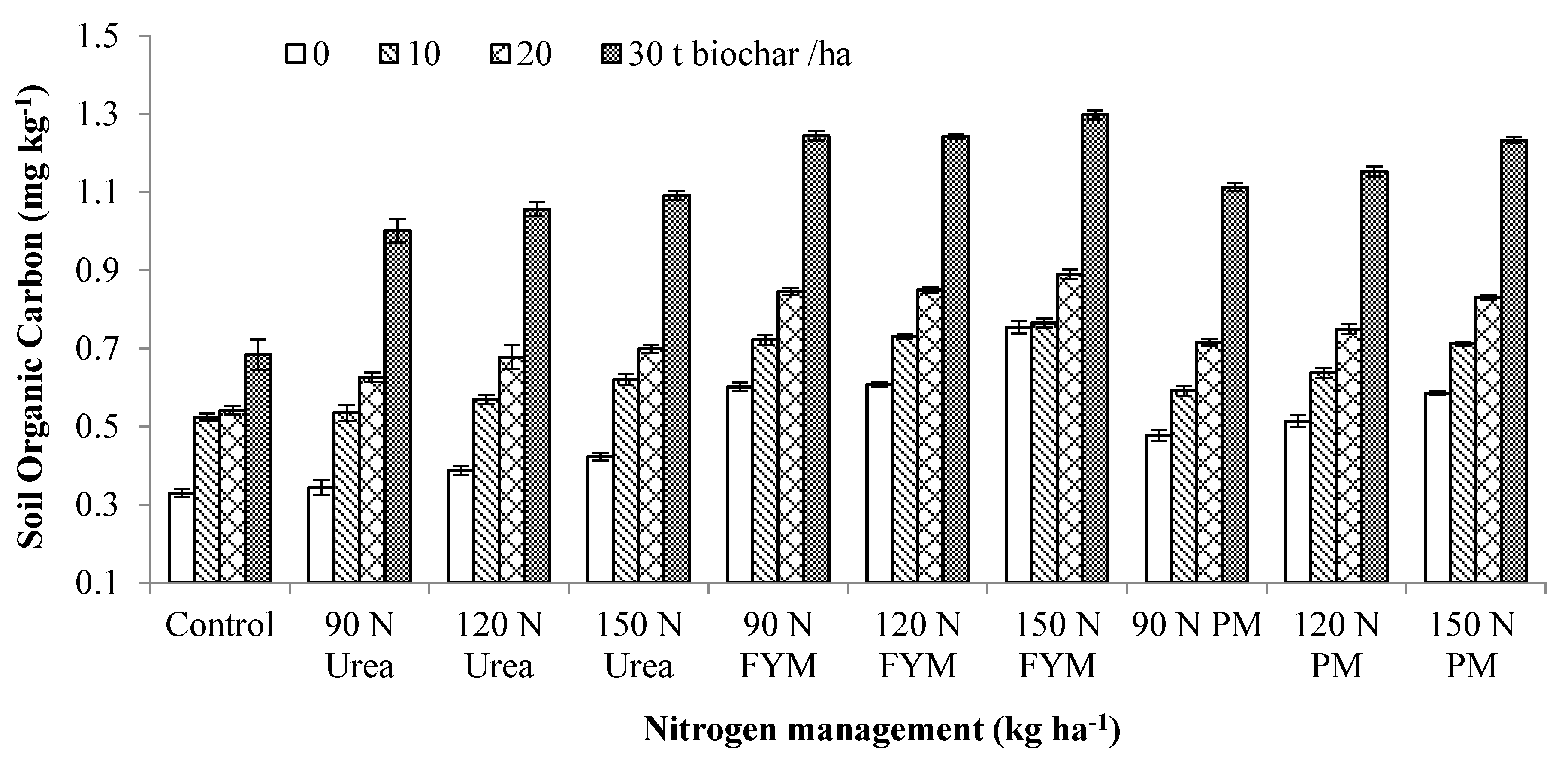
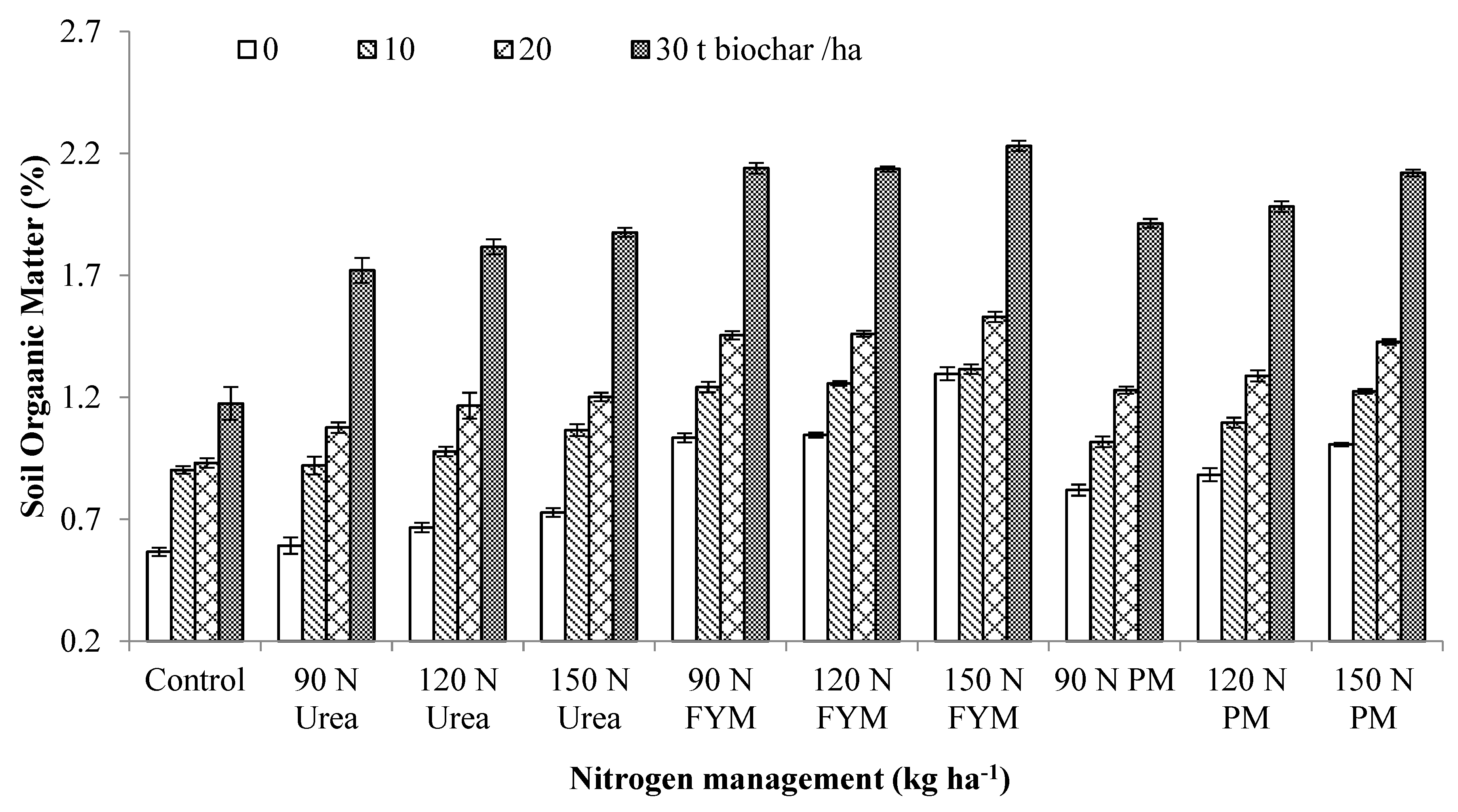
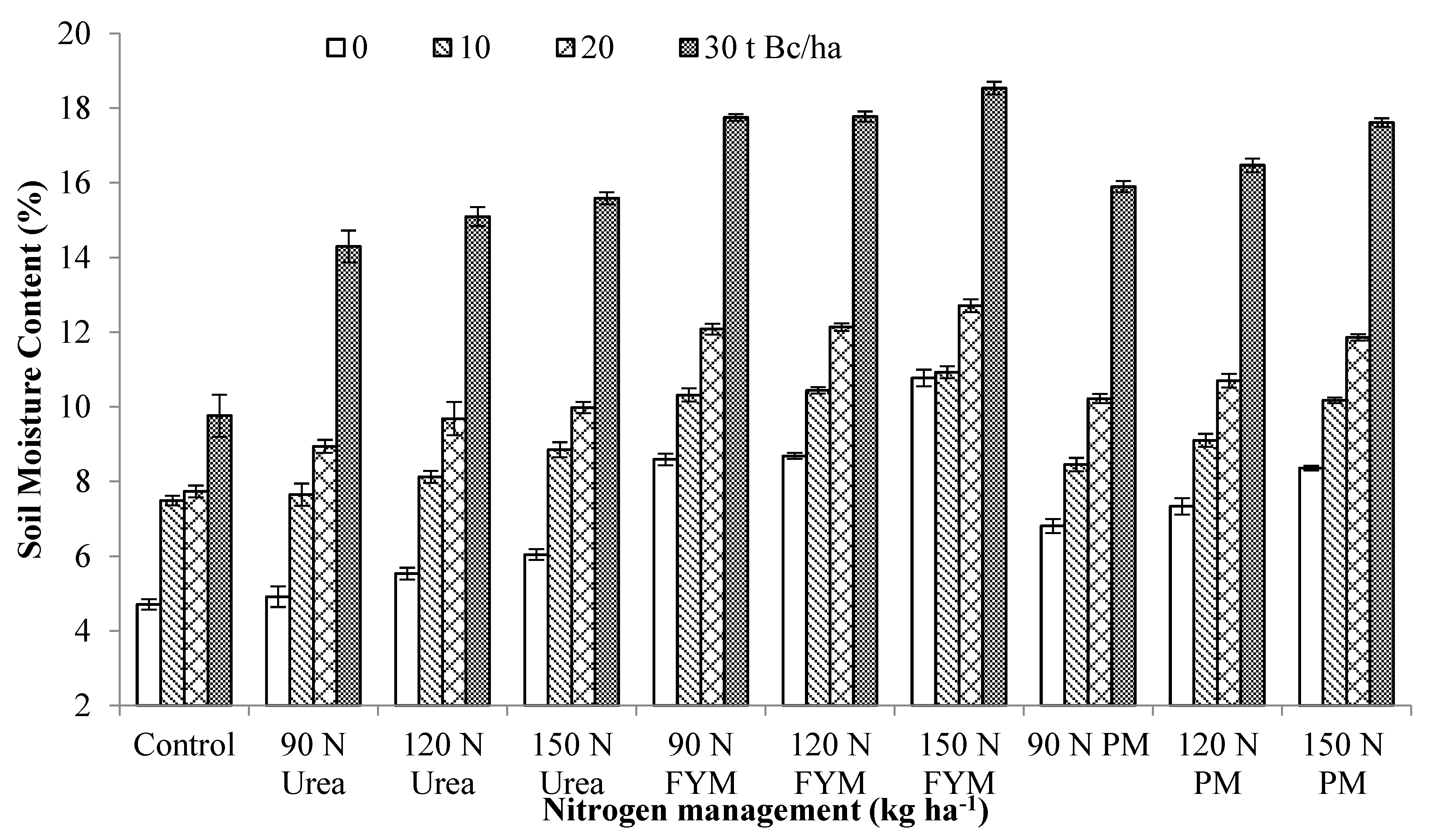
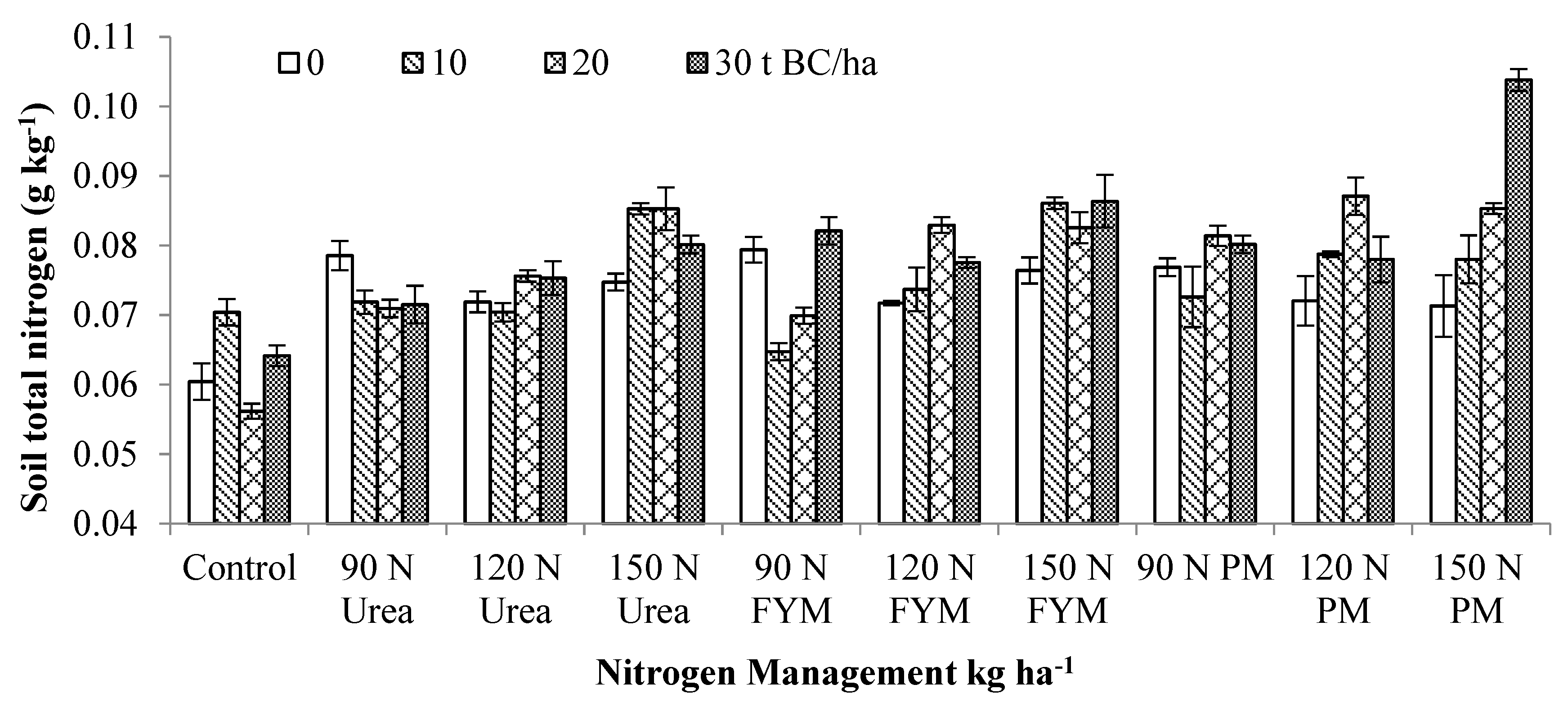
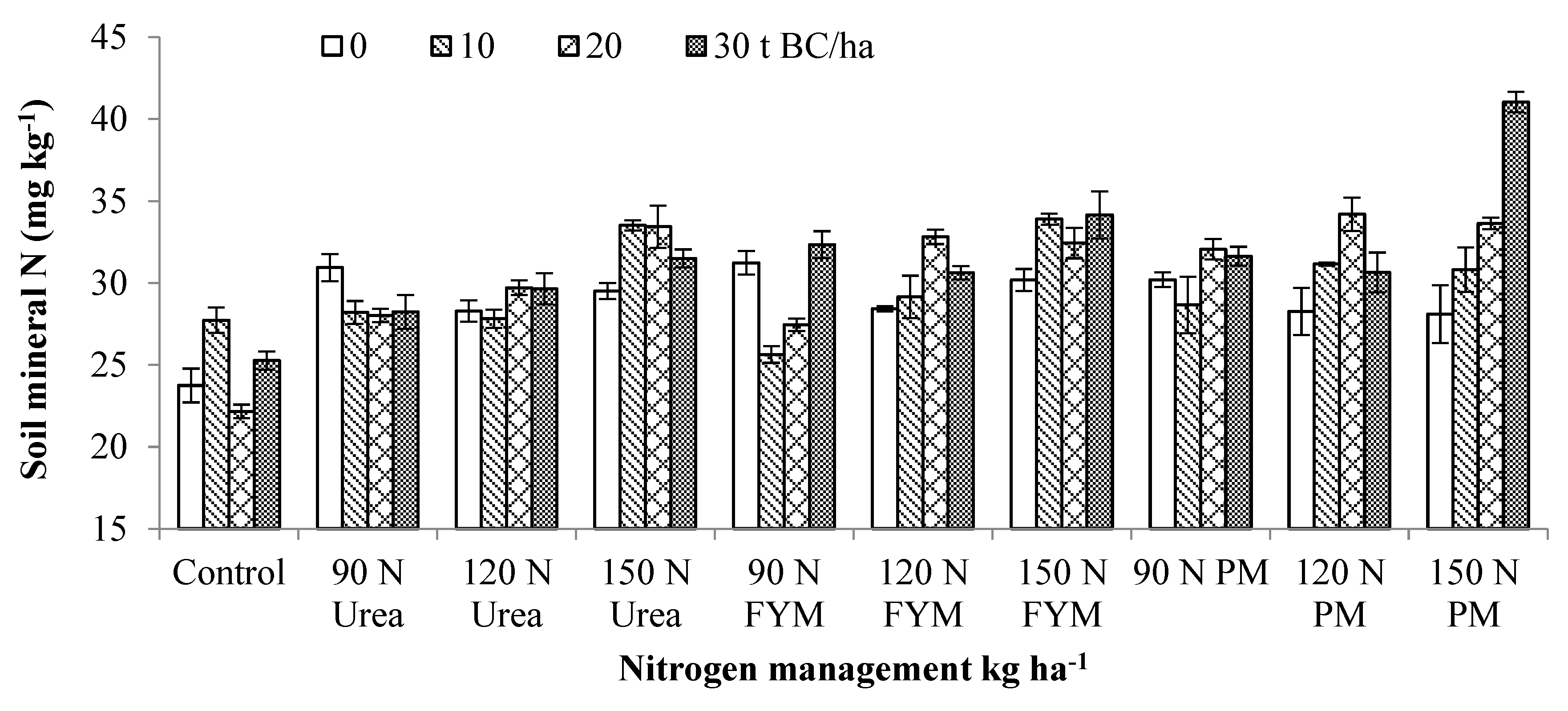
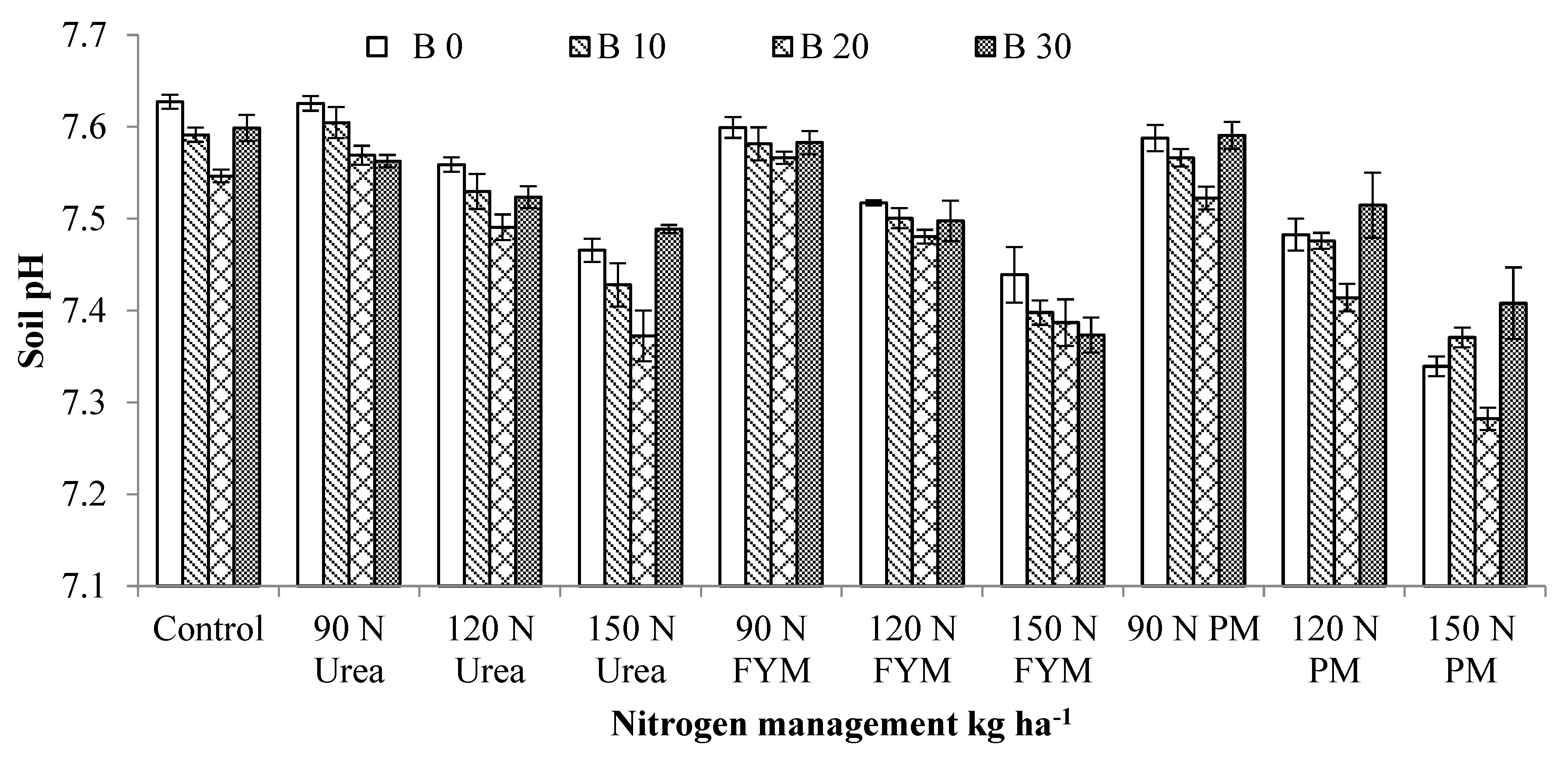
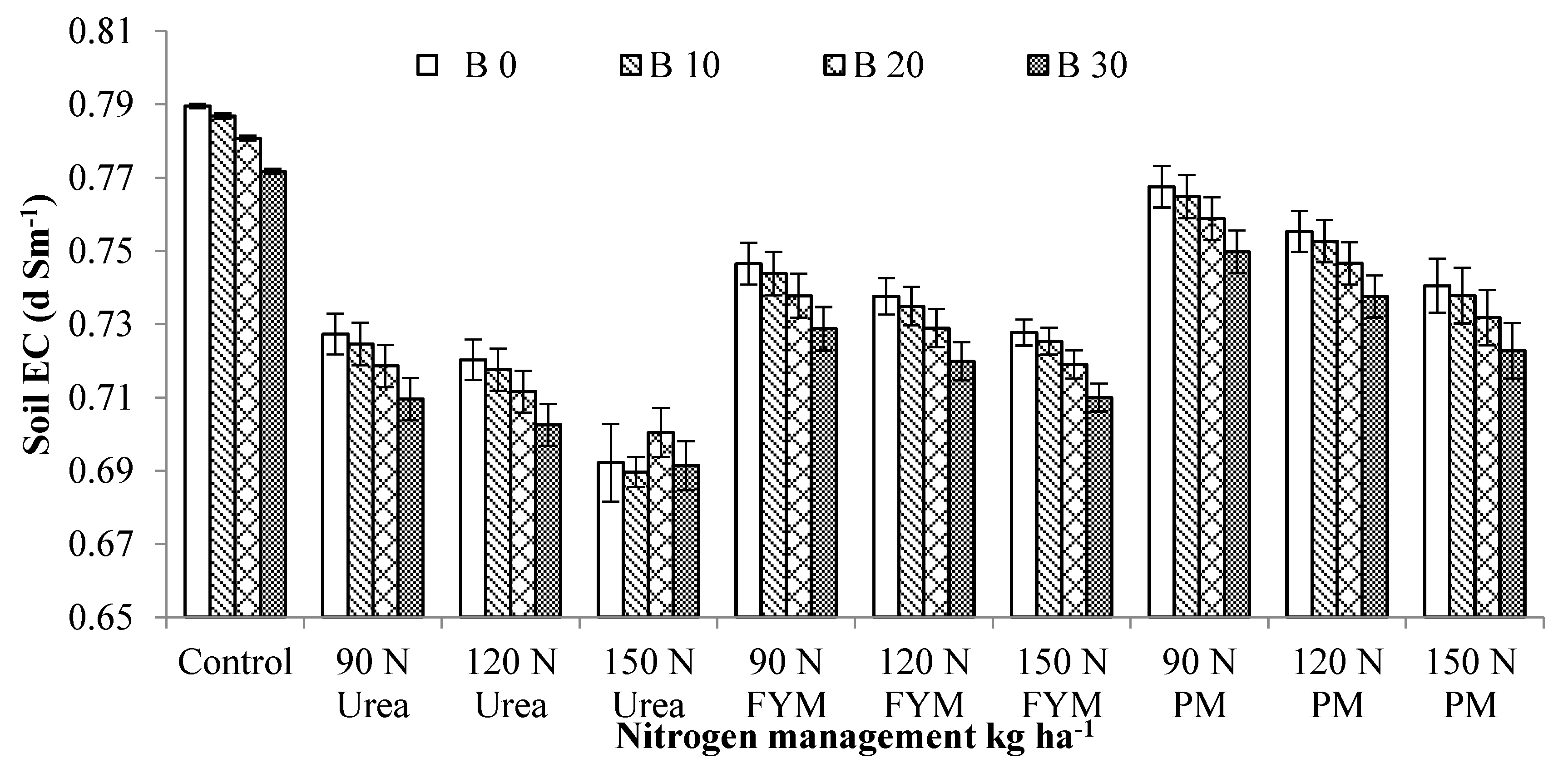
| Biochar (t ha-1) | SOC | SOM | SBD | SMC |
|---|---|---|---|---|
| 0 | 0.502 d | 0.864 d | 1.599 a | 7.174 d |
| 10 | 0.641 c | 1.102 c | 1.563 b | 9.152 c |
| 20 | 0.742 b | 1.277 b | 1.352 c | 10.603 b |
| 30 | 1.111 a | 1.911 a | 1.143 d | 15.876 a |
| LSD (P≤0.05) | 0.011 | 1.21 | 0.018 | 0.12 |
| Nitrogen Management (kg ha-1) | ||||
| Control | 0.520 g | 0.894 g | 1.565 a | 7.423 h |
| 90 N Urea | 0.626 f | 1.077 f | 1.535 b | 8.948 g |
| 120 N Urea | 0.673 e | 1.157 e | 1.533 b | 9.608 f |
| 150 N Urea | 0.708 d | 1.218 d | 1.503 c | 10.115 e |
| 90 N FYM | 0.853 b | 1.468 b | 1.402 3 | 12.185 bc |
| 120 N FYM | 0.858 b | 1.475 b | 1.320 g | 12.257 b |
| 150 N FYM | 0.926 a | 1.593 a | 1.244 h | 13.235 a |
| 90 N PM | 0.724 d | 1.245 d | 1.430 d | 10.343 e |
| 120 N PM | 0.763 c | 1.312 c | 1.359 f | 10.901 d |
| 150 N PM | 0.840 b | 1.445 b | 1.250 h | 12.001 c |
| LSD (P≤0.05) | 0.018 | 0.03 | 0.028 | 2.26 |
| 2015-16 | 0.721 b | 1.240 b | 1.445 | 10.302 b |
| 2016-17 | 0.777 a | 1.337 a | 1.383 | 11.101 a |
| Interaction | P≤0.05 | P≤0.05 | P≤0.05 | P≤0.05 |
| BC x N | Figure 1 | Figure 2 | Ns | Figure 3 |
| Biochar (t ha-1) | STN | SMN | pH | EC |
|---|---|---|---|---|
| 0 | 0.073 b | 28.88 c | 7.52 a | 0.740 a |
| 10 | 0.075 b | 29.65 c | 7.50 b | 0.738 b |
| 20 | 0.078 a | 30.59 b | 7.46 c | 0.733 c |
| 30 | 0.080 a | 31.50 a | 7.51 ab | 0.724 d |
| LSD (P≤0.05) | 0.003 | 1.10 | 0.04 | 0.0004 |
| Nitrogen Management (kg ha-1) | ||||
| Control | 0.063 e | 24.72 g | 7.59 a | 0.782 a |
| 90 N Urea | 0.073 d | 28.84 f | 7.59 a | 0.720 f |
| 120 N Urea | 0.073 d | 28.86 f | 7.53 b | 0.713 g |
| 150 N Urea | 0.081 ab | 31.98 bc | 7.44 d | 0.693 h |
| 90 N FYM | 0.074 d | 29.16 ef | 7.58 a | 0.739 d |
| 120 N FYM | 0.076 cd | 30.25 de | 7.50 b | 0.730 e |
| 150 N FYM | 0.083 a | 32.66 ab | 7.40 e | 0.721 f |
| 90 N PM | 0.078 c | 30.63 cd | 7.57 a | 0.760 b |
| 120 N PM | 0.079 bc | 31.06 cd | 7.47 c | 0.748 c |
| 150 N PM | 0.085 a | 33.39 a | 7.35 f | 0.733 e |
| LSD (P≤0.05) | 0.003 | 1.36 | 0.02 | 0.003 |
| 2015-16 | 0.074 b | 29.2 b | 7.49 | 0.734 b |
| 2016-17 | 0.079 a | 31.1 a | 7.52 | 0.735 a |
| Interaction | P≤0.05 | P≤0.05 | P≤0.05 | P≤0.05 |
| BC x N | Figure 4 | Figure 5 | Figure 6 | Figure 7 |
Disclaimer/Publisher’s Note: The statements, opinions and data contained in all publications are solely those of the individual author(s) and contributor(s) and not of MDPI and/or the editor(s). MDPI and/or the editor(s) disclaim responsibility for any injury to people or property resulting from any ideas, methods, instructions or products referred to in the content. |
© 2024 by the authors. Licensee MDPI, Basel, Switzerland. This article is an open access article distributed under the terms and conditions of the Creative Commons Attribution (CC BY) license (http://creativecommons.org/licenses/by/4.0/).





